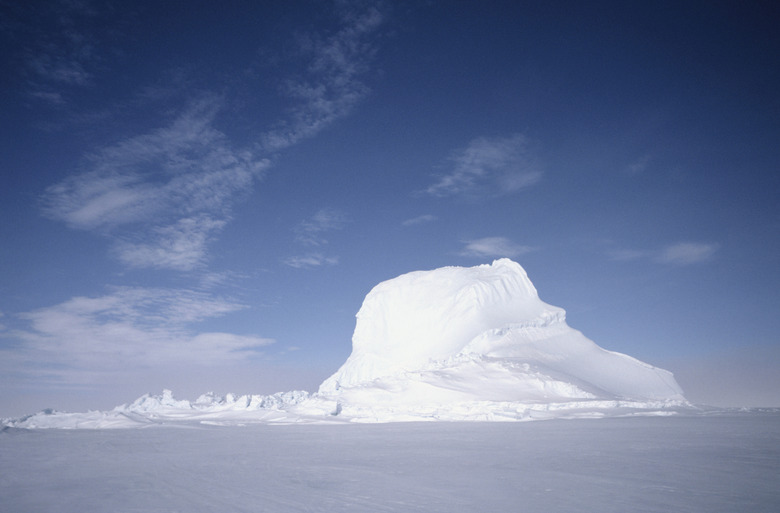What Is The Temperature Around Icebergs?
The ocean-going ice cubes we call icebergs are infamous for the danger they pose to ships like the ill-fated Titanic. But aside from their unpleasant reputation, these marvels are fascinating in their own right. For one thing, they provide an interesting example of how temperature affects the rate of melting. Most icebergs can survive for quite some time in the frigid waters of the Arctic or Antarctic but rapidly break up when they reach warmer waters.
Melting
If you take a freshwater ice cube and put it in an environment at exactly 0 degrees Celsius (32 degrees Fahrenheit), the water molecules on the surface of the cube will be freezing and melting at exactly the same rate, so the size of the cube will not change. Raising the temperature causes the rate of melting to exceed the rate of freezing, so the ice cube starts to melt. The same holds true for an iceberg. However, in the case of an iceberg the freezing point of the surrounding water is below zero thanks to the salt, so even at 0 degrees Celcius an iceberg (which is freshwater) melts slowly. The rate at which it melts increases as the iceberg moves toward the equator and the temperature of the surrounding water increases.
Salt Water
You've probably seen salt applied to sidewalks in winter to melt the ice. The salt isn't actually melting the ice directly, however; what it's doing is dissolving in water on the surface of the ice and decreasing that water's freezing point. That means the water will not refreeze (while it's above saltwater's freezing point), and the ice will slowly melt because the rate of melting exceeds the rate at which new ice is forming. The same is true for an iceberg in Arctic or Antarctic waters. The temperature there is often slightly below freezing (for freshwater) but the high salt content of ocean water reduces its freezing point below 0 degrees Celsius, and the iceberg slowly melts.
Temperature Gradient
At its surface an iceberg is at the same temperature as the surrounding water. How cold or how warm this is depends on how far toward the equator the iceberg has wandered. Inside the iceberg, however, temperatures can be much colder — as cold as -15 to -20 degrees Celsius (5 to -4 degrees Fahrenheit) for icebergs off the coast of Newfoundland and Labrador, for example. Consequently, there's a temperature gradient throughout the iceberg, with the warmest regions on the outside and the coldest deep inside.
Ocean Temperature
The temperature of the surrounding water varies depending on both season and latitude. In July, for example, temperatures off of the mid-Alaska coast can go as high as 8 degrees Celsius (46 degrees Fahrenheit), whereas in winter they can run as low as -2 degrees Celsius (28 degrees Fahrenheit). The July temperatures farther south off of British Columbia, by contrast, are typically in the 12 to 16 degree range (53 to 61 degrees Fahrenheit). As long as they remain in the chilly waters of the Arctic and Antarctic regions, icebergs melt very slowly. Once they get out into the Atlantic or Pacific, however, they start to melt much more quickly.
Cite This Article
MLA
Brennan, John. "What Is The Temperature Around Icebergs?" sciencing.com, https://www.sciencing.com/temperature-around-icebergs-23231/. 24 April 2017.
APA
Brennan, John. (2017, April 24). What Is The Temperature Around Icebergs?. sciencing.com. Retrieved from https://www.sciencing.com/temperature-around-icebergs-23231/
Chicago
Brennan, John. What Is The Temperature Around Icebergs? last modified March 24, 2022. https://www.sciencing.com/temperature-around-icebergs-23231/
